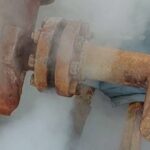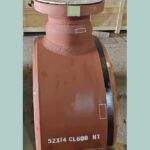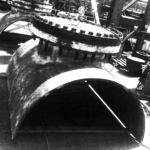01September 2021
On-line Sealing of Wellhead Master Valve Flange Leak
| Client | Kenya Electricity Generating Company (KenGen) |
| Country | Kenya |
| Service details | A leak from a piping system during operation can lead to the escape of line medium into the atmosphere and, depending on the severity of the leak, it could lead to an unplanned & costly shutdown. Wellube maintains a stock of semi-finished clamps and our in-house manufacturing facilities enables us to provide a quick turnaround to arrest leaks with minimal loss of production and environmental impact. Our selection of specially formulated compounds is compatible with most line mediums & temperatures encountered in normal plant operations. To know more, get in touch with us at enquiries@wellube.com |
Project Summary
Wellube has successfully sealed a leak in a wellhead master valve flange on a live pipeline which was operating between 1000 – 2000 psi and at a temperature of 200° C. The entire operation was carried out without shutting down the well, thus ensuring seamless operation for KenGen.
Leak arrested on the wellhead master valve flange with a ring clamp
Client Requirement
The client had a steam leak at one of the geothermal wells in Olkaria, Kenya. The leak was from the Master Valve Flange Joint which was operating between 1000 and 2000 psi at an operating temperature of 200 deg C. Wellube was asked to provide a solution that can be implemented without shutdown of the operating well and which will avoid quenching of the valve.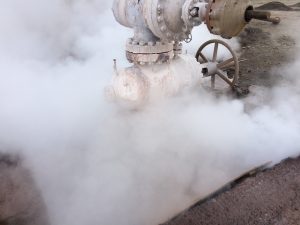
The leaking master valve flange
Challenges Faced
- There was no means to regulate the upstream steam flow, which was generated from the deep reservoir underground, this resulted in pressure and temperature fluctuations in the line.
- Silica particles were being entrapped in the flange bolt holes which presented difficulty in getting the sealant compound injected into the flange cavity to travel through the bolt holes. To solve this challenge, additional injection points were used on the flange periphery to ensure the injected sealant would travel through the flange bolt hole cavity to prevent the re-occurrence of leakage through the flange bolt holes in the future.
Solution Engineered
Wellube after analysis of the requirement, performed a detailed site survey to obtain the required field dimensions of the leaking flange joint and the nearest obstruction to determine the best possible solution. After the survey, it was determined that a ring clamp would be installed that would fit in the gap between the flanges followed by injection of suitable sealant compounds. The flange insert-lip clamp was designed according to ASME Sec VIII DIV 1, this was clamped around the flange.
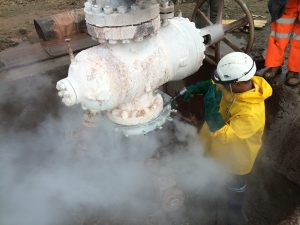
Ring clamp installation in progress to seal the leak
Design and manufacturing of the clamp were completed within 48 hours, following which the team was mobilized to the site along with the clamp, equipment and accessories. The leak was successfully arrested to the satisfaction of KenGen personnel at the site. By completing the work online, KenGen managed to avoid taking a well offline and prevented the inherent risk of quenching the well which may have resulted in the complete loss of well.Benefits Delivered
- Completed the project within schedule
- Avoided shutdown of the well, thus ensuring production continuity
- Quick and efficient solution
- Achieved 100% seal on the line.
- Fully HSEQ compliant


